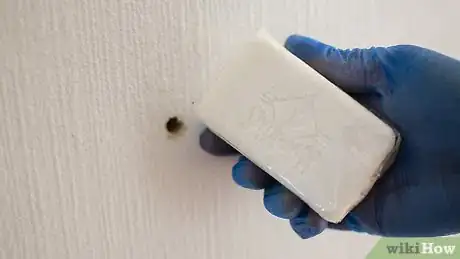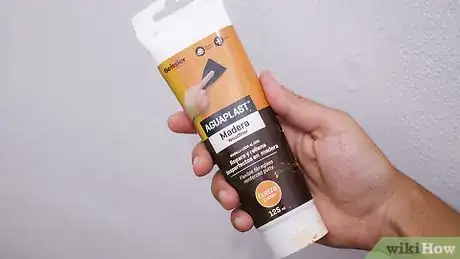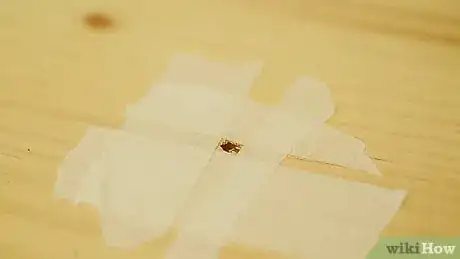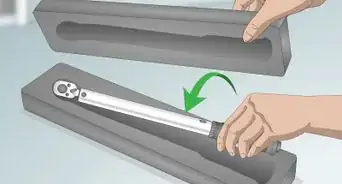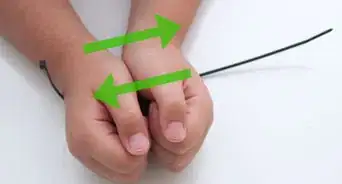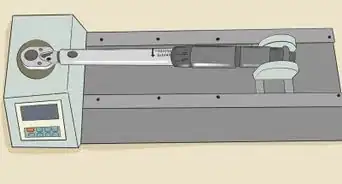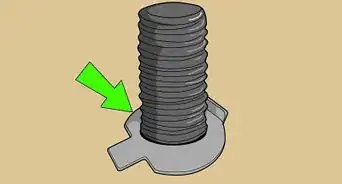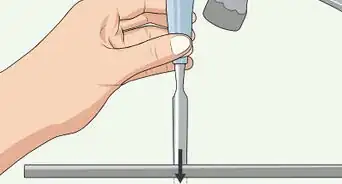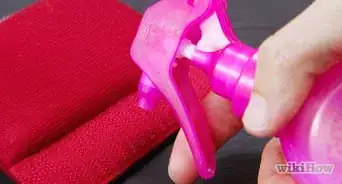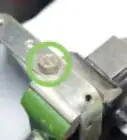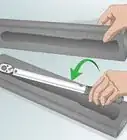This article was co-authored by Art Fricke. Art Fricke is a home renovation and repair specialist and the owner of Art Tile & Renovation based in Austin, Texas. With over 10 years of experience, he specializes in bathroom and kitchen renovations. Art focuses on a single contractor approach to customized renovation work, and performs projects such as installing custom tile showers, fixing tiled shower leaks, replacing cracked tiles, and installing floor and wall tile.
There are 8 references cited in this article, which can be found at the bottom of the page.
This article has been viewed 168,688 times.
You can fill nail holes the proper, long-lasting way by using spackling paste on both plaster walls and drywall, or wood putty on finished wood. For a quick fix, you can use everyday items like toothpaste, craft glue, or bar soap. Choose items that match your wall color or paint over the holes discretely after they are filled.
Steps
Filling Nail Holes in Walls
-
1Apply spackling paste to the holes with a putty knife. Purchase a tub or tube of spackling paste from your local hardware store. Smooth the area with a putty knife before applying a quarter-sized amount of spackling to it. Slowly drag the putty knife over the surface of each nail hole to fill it.[1]
Spackling paste is the best material to use to fill nail holes in either plaster walls or drywall in a long-lasting way. It is also called joint compound or patching compound.
-
2Remove any excess paste with a clean putty knife. Remove putty from the putty knife with a damp cloth. Drag the clean tool over the nail holes vertically and horizontally to remove excess putty. Repeat this step until the surface of the wall looks even. Let the putty dry for up to 1 hour.[2]
- You can also use a second putty knife, ruler, or kitchen knife for this step.
Advertisement -
3Sand the area lightly to ensure an even surface. Once the putty is dry, rub a piece of sandpaper or a sanding block over your spackled nail holes. Sand the area lightly until the surface looks even. Wipe away any sand dust with a clean, damp cloth.[3]
- For the best results, use a medium grit sandpaper to remove excess spackling paste, then a fine grit sandpaper to smooth the area.[4]
-
4Apply paint to the filled spots with a small paintbrush or paper towel. Apply a light covering of wall paint to a small paintbrush or paper towel. Lightly dab the filled nail holes to deposit the paint over them. Avoid applying a heavy coat of paint over the holes, which may leave obvious spots on your wall.[5]
- Use the same color of wall paint that is covering the rest of the wall.
Using Materials from Home for a Quick Fix
-
1Mix toothpaste and aspirin as an alternative to spackling paste. Use a mortar and pestle or a bowl and sturdy spoon to crush a tablet of aspirin. Squeeze out about .25 inches (0.64 cm) of toothpaste onto the aspirin powder and mix them together into a paste. Apply this thick mixture to small nail holes with a craft stick or other small, flat tool.[6]
- If the aspirin and toothpaste won't mix evenly, add a drop of water to the mixture.
- This filler can be used in drywall or plaster walls.
- Alternatively, make a paste using 1 tablespoon (9 g) of flour, 1 teaspoon (5 g) of salt, and a few drops of water.
-
2Rub a bar of soap over the holes to fill them without tools. Rub a dry bar of soap over your nail holes, back and forth. Stop once the holes look filled in. Run a dry cloth or rag over the surface of the holes to wipe excess soap pieces away.[7]
- Avoid using a wet or damp rag, which can melt or dissolve the soap.
- Opt for a white soap if you have white walls.
- You can use this method for either drywall or plaster walls.
-
3Squeeze craft glue into nail holes to fill them quickly. Purchase a bottle of white craft glue online or from a craft store. Position the nozzle in front of each nail hole and carefully squeeze in glue until the hole is full. Wait for the glue to dry, then scrape away any excess glue around the outside of the hole.[8]
- You can also apply craft glue to the nail holes with a cotton swab.
- Add a sprinkle of baking soda to the glue if you want a filler with a thicker consistency.
- This quick solution can be used for plaster walls and drywall.
-
4Rub a crayon over the nail holes to disguise holes and match your wall color. Select a wax crayon that is relatively similar to your wall color. Insert the tip of the crayon into the hole and twist it back and forth to deposit wax into the hole. When it is filled, wipe the surface with a clean cloth to remove excess pieces of crayon.[9]
- The crayon does not have to match your wall color exactly as it will look blended to the naked eye.
- Crayon can be used to fill nail holes in drywall or plaster walls.
Fixing Nails Holes in Finished Wood
-
1Purchase a wood putty that matches the finish of your wood. Wood putty comes in a variety of shades to match different types of wood and finishes. Purchase a putty that matches your wood as closely as possible. To make this easy, take a picture of the wood to refer to when you are making your purchase.[10]
- You can make your own wood putty by using sawdust from the wood and white wood glue.
- If you are going to refinish the wooden surface afterwards, it doesn't matter if the putty matches the color of wood, as you will paint over it anyway.
-
2Place painter's tape around the nail hole to protect the surrounding wood. Poke a nail-sized hole in a piece of painter's tape using a screwdriver, utility knife, or another tool. Line up the tape over the nail hole. Gently press down on the tape to adhere it to the wood.
- Use more than one piece of tape if needed.
-
3Apply the wood putty to the nail hole with a putty knife. Put a quarter size amount of wood putty onto the tip of a clean putty knife. Gently scrape the knife across the painter's tape over the nail hole. Apply putty until the hole is filled.[11]
- Scrape away any putty that is protruding out of the hole as it will expand slightly as it dries.
-
4Remove the tape and polish the area with a dry rag. Pull the tape away from the wood very gently to avoid damage. Rub a clean, dry rag over the surface of the filled nail hole to smooth it. Avoid using a damp rag, which could smudge the putty.[12]
Community Q&A
Did you know you can get answers researched by wikiHow Staff?
Unlock staff-researched answers by supporting wikiHow
-
QuestionHow do you fill nail holes without painting?
 wikiHow Staff EditorThis answer was written by one of our trained team of researchers who validated it for accuracy and comprehensiveness.
wikiHow Staff EditorThis answer was written by one of our trained team of researchers who validated it for accuracy and comprehensiveness.
Staff Answer wikiHow Staff EditorStaff AnswerIf your walls are white or off-white, you might be able to get away with patching the holes with a little spackle and leaving it unpainted. Wipe away any excess spackle around the hole with a damp cloth so it doesn’t show up against the surrounding paint as much. You can use wood filler in a matching color if you’re patching a hole in unpainted wood.
wikiHow Staff EditorStaff AnswerIf your walls are white or off-white, you might be able to get away with patching the holes with a little spackle and leaving it unpainted. Wipe away any excess spackle around the hole with a damp cloth so it doesn’t show up against the surrounding paint as much. You can use wood filler in a matching color if you’re patching a hole in unpainted wood. -
QuestionAre you supposed to fill nail holes when you move?
 wikiHow Staff EditorThis answer was written by one of our trained team of researchers who validated it for accuracy and comprehensiveness.
wikiHow Staff EditorThis answer was written by one of our trained team of researchers who validated it for accuracy and comprehensiveness.
Staff Answer wikiHow Staff EditorStaff Answer
wikiHow Staff EditorStaff Answer -
QuestionWhat do painters use to fill nail holes?
 wikiHow Staff EditorThis answer was written by one of our trained team of researchers who validated it for accuracy and comprehensiveness.
wikiHow Staff EditorThis answer was written by one of our trained team of researchers who validated it for accuracy and comprehensiveness.
Staff Answer wikiHow Staff EditorStaff Answer
wikiHow Staff EditorStaff Answer
Things You'll Need
Filling Nail Holes in Walls
- Spackling paste
- Putty knife
- Damp cloth
- Fine sandpaper
- Wall paint
- Small brush or paper towel
Fixing Nails Holes in Finished Wood
- Wood putty
- Putty knife
- Painter's tape
- Clean, dry cloth
Using Materials From Home for a Quick Fix
- Bar soap
- Toothpaste
- Aspirin
- Craft clue
- Baking soda
- Wax crayons
References
- ↑ http://www.unpakt.com/blog/diy-ways-to-fill-nail-holes/
- ↑ http://www.unpakt.com/blog/diy-ways-to-fill-nail-holes/
- ↑ https://www.apartmentguide.com/blog/moving-out-fix-common-damage/
- ↑ https://homebuilding.thefuntimesguide.com/how_to_spackle_drywall/
- ↑ https://thediyplaybook.com/2015/08/fix-nail-holes-wall.html
- ↑ https://www.updater.com/moving-tips/diy-tips-to-fill-nail-holes-in-the-wall
- ↑ http://www.unpakt.com/blog/diy-ways-to-fill-nail-holes/
- ↑ https://www.updater.com/moving-tips/diy-tips-to-fill-nail-holes-in-the-wall
- ↑ https://www.today.com/home/how-fill-nail-hole-left-hanging-painting-t127187
About This Article
To fill nail holes, rub a bar of soap over the surface until the holes are filled in. For another quick solution, squeeze white craft glue into the hole. You can also crush an aspirin tablet, mix the powder with toothpaste, and fill the hole with the mixture. Alternatively, try making a paste out of flour, water, and salt. If you want to take a more professional approach, purchase spackling paste, and apply it to the hole with a putty knife. To learn more, including how to fill nail holes in finished wood, read on!
